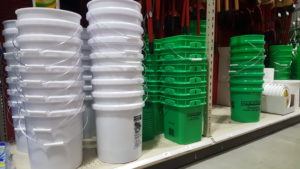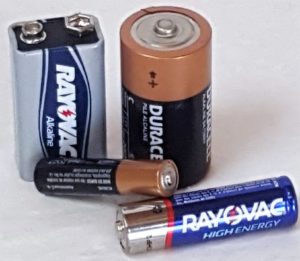This article will explain the Hazardous Materials Regulations (HMR) of the USDOT/PHMSA for the packaging and transport of lithium cells or batteries shipped for disposal or recycling.
The transportation in commerce of lithium cells or batteries is subject to myriad regulations, both domestic and international. However, within the HMR at 49 CFR 173.185(d) is an exception to full regulation for lithium cells or batteries when shipped for the purposes of disposal or recycling.
Before we begin…
Though brief – two sentences making one paragraph – the exception contains terms identified elsewhere in the HMR and references to other regulations as a condition of compliance. It will be helpful to identify some of these up front.
- The explanation of some terms: battery v. cell, lithium metal v. lithium ion, & the battery’s configuration, &etc. are best left to another article that explains them more in-depth. Read: Classification of Lithium Batteries for Transportation in Commerce.
- The testing and record keeping requirements of §173.185(a) are referenced as one of the reliefs offered by this exception. While the testing and record keeping are to be performed by the lithium cell or battery manufacturer, it is the responsibility of the shipper to ensure the data is available.
- The exception requires the lithium cells or batteries to be packaged in a “strong outer packaging”. Definitions may vary but this could be something as simple as a sturdy cardboard box. More description of a strong outer packaging is provided later in this article.
- The exception provides relief from the specification packaging requirements at §173.185(b)(3)(ii). A specification packaging is one designed, manufactured, tested, and marked to indicate it meets certain criteria established by the USDOT and/or the United Nations and will be able to withstand the conditions of transport.
- The U.S. Environmental Protection Agency (USEPA) requires a person to manage the waste it generates – including lithium cells or batteries shipped for recycling or disposal – subject to the regulations of the Resource Conservation and Recovery Act (RCRA). Lithium cells or batteries to be shipped for recycling or disposal may be managed as a hazardous waste with the characteristic of reactivity (D003). Lithium cells or batteries to be shipped for recycling only may be managed as a universal waste.
Contact me with any questions you may have about the transportation of hazardous materials by air, highway, vessel, or rail International and Domestic Daniels Training Services, Inc. 815.821.1550 |
Scope and applicability:
The exception is valuable to shippers of lithium cells and batteries transported for disposal or recycling but it has its limits. Be certain your intended shipment falls within the scope and applicability of the exception. The limits of the exception identified here apply to all lithium cells or batteries subject to §173.185(d).
- This particular exception is found only within the HMR of the USDOT/PHMSA. The Dangerous Goods Regulations of the International Air Transport Association (IATA) do not allow for the transport of lithium cells or batteries by air if shipped for the purpose of disposal or recycling. The Dangerous Goods Code of the International Maritime Organization (IMO) do allow for the transport of lithium cells or batteries by vessel for the purpose of disposal or recycling but not in the same manner as the USDOT/PHMSA.
- The exception does not apply to lithium cells or batteries that are damaged, defective, or part of a recall. Those are subject to regulation under §173.185(f).
- Both lithium cells and batteries are subject to this exception.
- Both lithium ion (including lithium ion polymer) and lithium metal (including lithium alloy) cells and batteries are subject to this exception.
- Of the three (3) possible configurations for shipping lithium cells and batteries, only two are subject to this exception:
- Lithium cells or batteries shipped alone – subject to the exception.
- Lithium cells or batteries contained in equipment – subject to the exception.
- Lithium cells or batteries packed with equipment – not mentioned in §173.185(d) and therefore – I believe – not subject to the exception.
- Mode of transportation must be by motor vehicle only. As noted earlier, the IATA Dangerous Goods Regulations do not allow for the transport of lithium cells or batteries by air for the purpose of disposal or recycling.
- Lithium cell or battery must be transported to one of the following:
- A facility permitted by USEPA or a state environmental agency – if the state has an authorized hazardous waste program – to store or dispose of lithium cells or batteries.
- A facility for the purpose of recycling the lithium cells or batteries. A recycling facility is not required to have a permit though under USEPA’s regulations a waste generator is responsible for the final disposal of the lithium cells or batteries.
Conditions of the exception and the relief from the HMR:
The conditions of the exception and the relief it offers can be divided into two parts. These two parts will be considered separately.
- Part 1 applies to all lithium cells or batteries shipped for disposal or recycling. It offers partial relief from the HMR if its conditions are met.
- Part 2 applies solely to a lithium cell or battery subject to the part 1 conditions that also meets the size, packaging, and hazard communication conditions in §173.185(c)(1)-(3); in other words, a “smaller lithium battery”. Those lithium cells or batteries subject to part 2 of the exception are excepted from most requirements of the HMR.
Daniels Training Services, Inc. 815.821.1550 |
Conditions of the exception (part 1):
Lithium cells or batteries must be packed in a “strong outer packaging”. For a detailed explanation of what USDOT/PHMSA means by a “strong outer packaging” refer to this article: What is a strong outer packaging? In brief, a strong outer packaging is:
- …outermost enclosure…
- …provides protection against release of contents…
- …sturdy, durable…
- …meets general packing requirements of §173, subpart B…
- …need not comply with specification packaging requirements of §178…

The packaging must comply with the general packing requirements of §173.24 (General requirements for packagings and packages) and §173.24a (Additional general requirements for non-bulk packagings and packages). These are the same general packing requirements to be met by a “strong outer packaging”. This isn’t nearly as challenging as it may seem. The general packing requirements – though too long to list in their entirety here – are pretty basic. In brief they are:
- No release of hazmat to the environment.
- Effectiveness of packaging not reduced by transport.
- No hazmat reside on outside of package.
- May only use authorized packaging.
- Packaging must be compatible with hazmat.
- Characteristics of hazmat must be within specifications of packaging (if specification packaging is used).
- More…
Though excepted from the specification packaging requirements of §173.185(b)(3) (see later in this article) the lithium cells or batteries must still comply with the following (LOI 15-0100 and LOI 14-0246):
- §173.185(b)(1) which mandates compliance with the general packing requirements of §173, subpart B (again?!?)
- §173.185(b)(2): lithium cells or batteries must be packaged in a manner to prevent all of the following:
- Short circuits.
- Movement within the outer package.
- Accidental activation of the equipment.
- §173.185(b)(3)(i) which requires lithium cells or batteries to be placed in non-metallic inner packagings that completely enclose the cells or batteries, and separate them from contact with equipment, other devices, or conductive materials (e.g. metal) in the package.

Relief from the HMR (part 1):
The conditions of part 1 of the exception – if complied with – offer the following relief from full regulation:
- The lithium cells or batteries are excepted from the testing and record keeping requirements of §173.185(a) which are explained in this article: General Requirements and Provisions for the Transportation of Lithium Batteries but you don’t need to read it. Just be glad that compliance with this paragraph means you don’t have to meet the testing and record keeping requirements for lithium cells or batteries.
- The “strong outer packaging” (see earlier in this article) used to contain the lithium cells or batteries for shipment does not need to meet the specification packaging requirements of §173.185(b)(3).
Conditions of the exception and relief from the HMR (part 2):
A lithium cell or battery in compliance with all of the conditions of part 1 that also meets the requirements of §173.185(c) for its size, packaging, and hazard communication (otherwise known as a “smaller lithium cell or battery”) is not subject to any other requirements found in the HMR for the following:
- Shipping papers
- Package marks or markings
- HazMat labels
- Placards
- Emergency information
- HazMat Employee training
What is a “smaller lithium cell or battery”?
| Industry and EPA hazardous waste No. | Hazardous waste | Hazard code |
|---|---|---|
| F020 | Wastes (except wastewater and spent carbon from hydrogen chloride purification) from the production or manufacturing use (as a reactant, chemical intermediate, or component in a formulating process) of tri- or tetrachlorophenol, or of intermediates used to produce their pesticide derivatives. (This listing does not include wastes from the production of Hexachlorophene from highly purified 2,4,5-trichlorophenol.) | (H) |
| F021 | Wastes (except wastewater and spent carbon from hydrogen chloride purification) from the production or manufacturing use (as a reactant, chemical intermediate, or component in a formulating process) of pentachlorophenol, or of intermediates used to produce its derivatives | (H) |
| F022 | Wastes (except wastewater and spent carbon from hydrogen chloride purification) from the manufacturing use (as a reactant, chemical intermediate, or component in a formulating process) of tetra-, penta-, or hexachlorobenzenes under alkaline conditions | (H) |
| F023 | Wastes (except wastewater and spent carbon from hydrogen chloride purification) from the production of materials on equipment previously used for the production or manufacturing use (as a reactant, chemical intermediate, or component in a formulating process) of tri- and tetrachlorophenols. (This listing does not include wastes from equipment used only for the production or use of Hexachlorophene from highly purified 2,4,5-trichlorophenol.) | (H) |
| F026 | Wastes (except wastewater and spent carbon from hydrogen chloride purification) from the production of materials on equipment previously used for the manufacturing use (as a reactant, chemical intermediate, or component in a formulating process) of tetra-, penta-, or hexachlorobenzene under alkaline conditions | (H) |
| F027 | Discarded unused formulations containing tri-, tetra-, or pentachlorophenol or discarded unused formulations containing compounds derived from these chlorophenols. (This listing does not include formulations containing Hexachlorophene sythesized from prepurified 2,4,5-trichlorophenol as the sole component.) | (H) |

As a rule of thumb: most lithium cells or batteries used in consumer products meet the definition of a “smaller lithium cell or battery”.
For a complete description of the packaging and hazard communication requirements of §173.185(c) you’ll have to research it yourself or wait for a later article. The most restrictive requirement applicable to shipments of lithium cells or batteries for disposal or recycling is found at §173.185(c)(1)(vi) which limits the gross package weight to no more than 30 kg (66 lb) unless the lithium cells or batteries are contained in equipment.
If you like this information, please share it using any of the social media platforms identified below. You’ll look real smart recommending my articles! |
In sum:
That may seem like a lot – and it is! But if you’ll allow me to break it down into some common language and make a few generalizations you’ll see that this exception offers pretty good relief from full regulation without too much trouble.
- Accumulate and ship lithium cells and batteries gathered from consumer devices.
- Package each lithium cell or battery in a plastic sandwich bag.
- Place each lithium cell or battery in a sturdy cardboard or plastic container purchased at a hardware store.
- Manage the lithium cells or batteries as a universal waste per USEPA regulations.
- Maintain the gross package weight to no more than 30 kg (66 lb). For this reason it might be a good idea to limit the packaging to a volume of 5-gallons.
- Use some common sense when filling and closing the packaging.
- Display the lithium battery mark or the lithium battery handling label (only until 12.31.18) on the package when prepared for off-site transportation.
- As of March 6, 2019 the package must now display some label or mark indicating it is not allowed on passenger aircraft – even when shipped by ground! Read about it here: March 6, 2019, USDOT Changes Regulations for Shipping Lithium Batteries.
And that’s it!
As you can see, the transport of lithium cells or batteries is not easy and is not likely to get any easier. If you ship lithium cells or batteries for any reason other than for recycling or disposal you will be subject to entirely different – and likely more strict – regulations. Be sure to carefully research the regulations and consult with an expert before you make a critical decision.
Frequently Asked Questions:
Q: May lithium ion cells and batteries and lithium metal cells and batteries be combined in the same package in compliance with §173.185(d)?
A: Yes (LOI 15-0163).
Q: May dry cell alkaline batteries and lithium cells and batteries be combined in the same package in compliance with 173.185(d)?
A: Yes, if the dry cell alkaline batteries meet all of the requirements of Special Provision 130(b) and are therefore no longer subject to the HMR, i.e. a non-hazardous material, when transported by highway. Note: there is an exception for used dry-cell alkaline batteries shipped for recycling or disposal at Special Provision 130(d). Used dry-cell alkaline batteries shipped subject to the exception at Special Provision 130(d) may not be combined in the same package with batteries of a different chemistry, i.e. lithium cells or batteries (LOI 09-0160).
Q: May batteries of a different chemistry, such as a lead-acid battery, and lithium cells and batteries be combined in the same package in compliance with §173.185(d)?
A: No. The scope and applicability of §173.185(d) is limited solely to lithium cells and batteries. Only non-hazardous materials (e.g. a used dry-cell alkaline battery in compliance with Special Provision 130(b)) may be combined with lithium cells and batteries in compliance with §173.185(d). Note: in all cases the shipper is required to ensure the materials combined in a package will not react violently or prove incompatible to the contents or the packaging.
Q: What’s the big deal about lithium cells and batteries?
A: Test data has shown that even while partially discharged, lithium cells and batteries pose a risk of evolving a dangerous quantity of heat while in transportation (LOI 09-0160).
Q: Can damaged, defective, or recalled lithium cells or batteries be transported in comliance with the HMR?
A: Yes, if done in compliance with §173.185(f).
Q: Is §173.185(d) my only option for shipping lithium cells or batteries for recycling or disposal?
A: No. §173.185(g) allows a shipper to obtain an approval from USDOT/PHMSA to ship lithium cells or batteries in a manner not prescribed by the HMR. A shipper also has the option to obtain a special permit to allow it to ship hazardous materials in a manner not prescribed by the HMR. Read: Special Permits, Exemptions, Approvals, and Exceptions to the Hazardous Materials Regulations
Daniels Training Services, Inc. 815.821.1550 |
